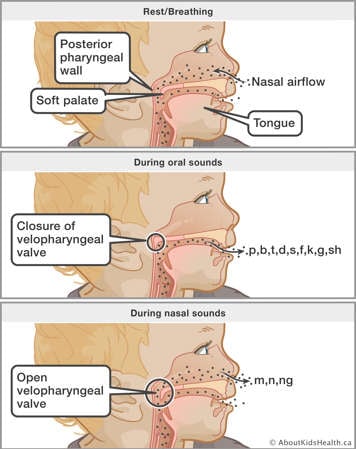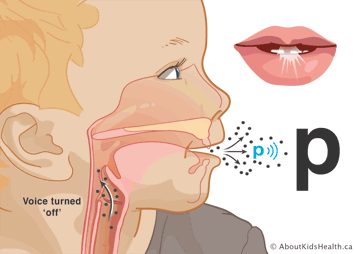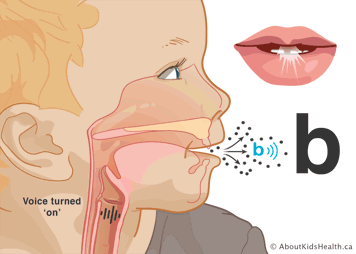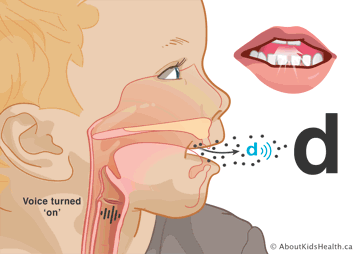There are speech and language skills you can help your child develop after their cleft palate repair surgery. Children learn best during positive interactions, so make communicating with your child a fun experience.
Help your child develop early language
Be face to face: Physically get down to your child’s level. This improves eye contact and focuses your child’s attention on your face and mouth.
Follow your child’s lead: Watch to see what your child is interested in and likes to play with. Join in your child’s play. Praise all attempts they make at communication.
Keep your language simple: Use short phrases and sentences. Your language should be one step ahead of your child’s language level. For example, if your child uses single words (e.g., "hi"), you can use a two-word combination (e.g., "hi baby"). Provide a good speech model by speaking slowly and clearly.
Talk to your child: Talk about what you are doing so your child hears a lot of language throughout the day (e.g., when doing dishes say "Uh-oh, dirty dish. Wash dish. Look, bubbles.") Also talk about what your child sees, hears or does by naming and expanding on it (e.g., "car", "go car", "fast car").
Say it once, say it again and again: Repetition is important in early learning. Repeat, repeat, repeat!
Ask fewer questions: Ask open-ended questions (e.g., "What happened?") or use choice questions (e.g., "Do you want apple or banana?”). Avoid questions that require only yes/no answers (e.g., "Do you want milk?"). Comment on what you see rather than asking "What’s that?" (e.g., "I see cow. Cow says moo.")
Keep the environment positive for communication: Pay attention to your child’s communication attempts and take turns like it is a conversation. Try to avoid pressuring your child to perform. Give your child a chance to respond by waiting.
For more language-building tips for parents of young children visit:
- https://www.toronto.ca/community-people/children-parenting/pregnancy-and-parenting/parenting/speech-language-vision-hearing/speech-and-language/help-your-child-now/ (*video clips and information available in multiple languages)
- http://www.hanen.org/information-tips-/use-a-variety-of-word-types-to-build-your-child's-language
Learning more than one language
Talk to your child in your first language. Children learn a language best from people who speak that language well and often. Children need consistent and frequent exposure to each language. Some ways to do this are:
- One parent – one language (e.g., one parent speaks Mandarin and one parent speaks English)
- One location – one language (e.g., English is spoken at daycare and Urdu is spoken at home)
- One activity – one language (e.g., English is spoken at mealtimes and French the rest of the day)
Plan activities in the community that will expose your child to another language (e.g., playgroup in English at an Ontario Early Years Centre). Children learning two languages typically follow the same milestones as children learning one language. If you are concerned about your child’s ability to learn their first language, speak to a Speech-Language Pathologist.
For more information visit:
https://www.beststart.org/resources/hlthy_chld_dev/BSRC_When_Families_Speak_fnl.pdf
Online courses for parents
Being the Bridge: Building Language While You Wait (for parents of newborns - 2.5 years of age)
An e-learning course that provides parents with information on the role of attachment and routines in language development. It also looks at how communication develops from birth and provides practical strategies to promote your child’s understanding and use of language at home.
http://childdevelopmentprograms.ca/elearning-modules/being-the-bridge/
The Power of Play: Creating Opportunities for Speech & Language Development for Parents of Preschoolers (2.5 – 4 years of age)
An e-learning course that provides parents with information on how play skills and peer interaction skills develop. It explores the link between pretend play, and cognitive and language development. It also provides practical strategies for promoting your child’s understanding and use of language within playful activities at home.
http://childdevelopmentprograms.ca/elearning-modules/the-power-of-play/
Let’s Talk! Tips for Building Your Child’s Speech and Language Skills
This video series was developed by the Eastern Ontario Health Unit to help parents support and strengthen their child’s developing communication skills. The series, available in English and French, demonstrates some of the communication milestones children should be reaching from infancy through age five. It also offers tips and strategies on how parents can help develop their child’s speech and language skills during this important period.
https://eohu.ca//talk/
Help your child develop early speech sounds
How speech is produced

It is important to know how speech is produced to be able to understand why some sounds may be more difficult than others for your child to produce. Before the repair of a cleft palate, your child should be able to make a variety of vowel sounds (ah, oh, oo, ee) and nose sounds (m, n). Speech sounds that do not need air pressure to build up in the mouth (h, w, y) can also be made before cleft palate repair.
The ability to produce other early developing mouth sounds (p, b, t, d) is limited before cleft palate repair surgery. This is because the cleft palate makes it difficult to direct sound and air out of the mouth. After your child’s cleft palate has been repaired, your child should be encouraged to make sounds out of their mouth.
Encourage oral airflow (blowing air from mouth)
Blowing activities can be used to encourage your child to direct air out of their mouth rather than their nose. These activities help your child get used to oral airflow. This is a fun first step when you start to work on encouraging air and sound to come out of their mouth. If your child has difficulty, gently pinch their nostrils to help direct the air out of their mouth. You can also demonstrate on yourself. Examples of things that are good to use for blowing activities are:
- Easy party blowers/noisemakers
- Feathers
- Cotton balls
- Bubbles
- Paper strips
- Easy to blow musical instruments such as horns
Stimulate early speech sounds
It is important to remember that children do not learn all the sounds in a language at once. Some sounds are easier to make and those should be introduced first. Some sounds that are easiest for children to make include:
Early developing sounds: m n h w y p b t d
Expand your child’s vocabulary using easy sounds (m, n, h, w, y)
An important early step in speech development is to copy or imitate sounds. Children imitate sounds more easily than words. When you make a lot of sounds while playing with your child, they will begin to imitate these sounds as an important step to imitating words. Examples of sound imitation activities using the sounds m, n, h, w, y are:
| Cow "moo" | Cat "meow" | Horse "neigh" |
| Laughing "ha-ha-ha" | Ouch "ow" | Hooray "yay" |
| Monkey "hee-hee" | Baby "wah-wah" | Dog "woo(f)" |
When imitating words, your child is more likely to say words which contain sounds that are easy for them to produce. Use daily routines to allow for frequent repetition of words that have early developing sounds such as m, n, h, w, y.
| Sound | Sample words |
|---|---|
| m | mama, mommy, more, mine, me, milk, moon |
| n | no, nana, no more, one, on, night-night |
| h | hi, hello, oh-oh, hey, home, here |
| w | one, wawa, wee, ow (ouch) |
| y | yeah, you, eye, yummy |
Stimulate early developing oral sounds (/p/ and /b/, /t/ and /d/)
- Spend a few minutes each day practicing one sound. Do not move onto another sound until your child is making the sound you are working on with some consistency.
- Remember to focus on the sound you are working on. Other sounds in a word may still be difficult for your child to say.
- Activities that can help you focus on using certain speech sounds and allow for repetition include:
- Creating a scrapbook with pictures or looking at picture dictionaries so you and your child can look at the pictures and label them.
- Targeting words in daily activities. For example, if you are trying to get your child to make a /p/ sound, you can emphasize words that have that sound during bath time, play time, etc.
- You can also choose your own words that may reflect the language you speak at home or words that your child will want to use such as the names of people, pets, etc.
- The techniques listed below for each sound are organized in such a way as to increase your child’s chances of success. Start by seeing if your child can imitate just the sound. If your child can make the sound, then move on to getting them to make the sound combined with different vowels. Then move on to familiar, simple words.
- Children usually find it easier to make a sound at the beginning of the word.
"Lip" sounds – /p/ and /b/
Encourage lip closure by:
- Blowing kisses
- Making raspberry sounds with the lips
- Opening and closing the lips
- Playing imitation games (Simon Says, Follow the Leader, etc.)

Introduce the /p/ sound
Introduce the /p/ sound by bringing your lips together then opening your lips to push the air out with a puff of air. You can use a tissue, cotton ball, feather, etc. to show the puff of air. The /p/ sound is a "quiet" sound because the vocal cords do not vibrate.
For printed versions of this document, please visit aboutkidshealth.ca to view the full animation.

Introduce the /b/ sound
Introduce the /b/ sound by bringing your lips together and pushing the air out of your mouth by opening your lips in the same way as the /p/ sound, but with a louder sound for the /b/. The /b/ is a "voiced" sound as the vocal cords vibrate.
For printed versions of this document, please visit aboutkidshealth.ca to view the full animation.
| First with vowels | Then at the beginning of words | Then at the end of words | |||
|---|---|---|---|---|---|
| Poo Pee Pa Pie Pay Pow |
Boo Bee Boy Bye Bay Bow |
Papa Puppy Pop Pig Pet Pot |
Baby Ball Book Bath Bed Bubble |
Up Cup Top Nap Beep Hop |
Tub Web Cub Bib |
"Tongue" sounds – /t/ and /d/
Encourage tongue movements by:
- Sticking the tongue in and out, and side to side
- Making raspberry sounds with the tongue out
- Lifting the tip of the tongue behind the top teeth (place a small amount of your child’s favourite puree behind their top teeth and have them find it with their tongue)
- Playing imitation games (Simon Says, Follow the Leader, etc.)

Introduce the /t/ sound
Introduce the /t/ sound by encouraging your child to place the tip of their tongue up behind their top front teeth, then tapping the tongue with a puff of air, like a ticking clock sound. The /t/ sound is a "quiet" sound because the vocal cords do not vibrate.
For printed versions of this document, please visit aboutkidshealth.ca to view the full animation.

Introduce the /d/ sound
Introduce the /d/ sound by encouraging your child to place the tip of their tongue up behind the top front teeth and pushing the air out in the same way as for /t/, but with a louder sound for /d/. The /d/ is "voiced" as the vocal cords vibrate.
For printed versions of this document, please visit aboutkidshealth.ca to view the full animation.
| First with vowels | Then at the beginning of words | Then at the end of words | |||
|---|---|---|---|---|---|
| Ta Toe Tee Ta Toy Two |
Do Day Dee |
Top Tap Tub Time Tummy Teddy |
Daddy Door Dot Done Dog Doll |
Hat Hot Wait What Pat Eat |
Bad Food Bed Mad Hide Sad |
Even though you want your child to make more sounds, you need to be cautious not to reinforce sounds such as grunts, growls and throat sounds. Instead, encourage your child to make sounds using their lips and/or tongue. For example, it would be better for your child to say ‘mummle’ for ‘bubble’ or ‘nana’ for ‘dada’ instead of a grunt or growl sound for the /b/ or /d/. The focus at this early stage should be on encouraging the use of the lips and tongue.
Help your child practice during daily routines
Daily routines are a great way to improve speech and language development. Use language-building strategies while focusing on early speech sounds such as m, n, h, w, y, p, b, t and d during daily routines.
Getting dressed
- Use this time to teach your child about clothes and body parts (e.g., "hat on", "pants on", "shirt on", "arm in")
- Use choices to increase your child’s language (e.g., "socks first or pants first?")
Mealtime
- Model "mmmm" or "yum" and encourage your child to copy you
- Encourage your child to say "more" by waiting a few seconds then modelling the word before giving the next spoonful
- Other words you can encourage your child to say are "done", "hot" and "eat"
Song time
- Repetitive songs are good for teaching language. Encourage your child to participate in different ways such as banging a drum, doing actions for a song or trying to sing words that contain early sounds. Examples of songs you can try are:
- "The Wheels on the Bus" - "beep", "open"
- "Old MacDonald Had a Farm" – "woo(f)", "meow"
Play time
- Make animal sounds such as "moo", "baa" and "neigh" while playing with farm toys
- Gather toys with p, b, t and d sounds (e.g., pig, puppy, ball, bear, book, top, doll) and place them in a basket. Encourage your child to say "hi" or name each toy. You can also model phrases (e.g., "hi puppy", "open book")
Clean-up time
- Name toys and see if your child can find the one that you name
- Work on following directions such as "put the puppy in the box"
- Make clean up time a game to encourage saying "bye" or "away" to the toys
Bath time
- Play with bubbles or toys in the bath, saying words such as "bubble", "pop", "boat" and "duck"
- Encourage your child to say parts of the body such as "head", "nose", "toe", "belly", "tummy" and "toe"
Story time
- Read the same book over and over so your child begins to learn it. This allows your child to use sounds or words to finish parts of the book
- Name the pictures in the book and encourage repetition of the words
Bedtime
- Give your child some stuffed animals. Ask the child to put each one down for a nap while saying "nap"
- Have your child say "night-night" or "bye-bye" to objects in the room and to family members (e.g., "mama", "dada", "papa" and "nana")
Fun sounds to encourage first words
| Animal sounds | Transportation | Exclamation | Other sounds |
|---|---|---|---|
| ▯ Meow ▯ Moo ▯ Neigh ▯ Baa ▯ Peep ▯ Woof |
▯ Beep-beep ▯ Toot-toot ▯ Vroom-vroom |
▯ Mmmmm ▯ Ha-ha-ha ▯ Uh-oh ▯ Huh? ▯ Wow ▯ Boo! |
▯ __________ ▯ __________ ▯ __________ ▯ __________ |
Common first words to get you started
| Social words | People | Body parts/Clothing |
|---|---|---|
| ▯ Hi/Bye ▯ More ▯ All done ▯ Yes/No ▯ Please ▯ Thank-you ▯ Help ▯ Night-night |
▯ Mama/Mom ▯ Dada/Dad ▯ Baby |
▯ Tummy ▯ Eyes ▯ Toes ▯ Nose ▯ Boots ▯ Hat ▯ Pants ▯ Shoes |
| Action words | Location words | Play |
|---|---|---|
| ▯ Eat ▯ Drink ▯ Open ▯ Walk ▯ Go |
▯ In/Out ▯ On/Off ▯ Up/Down ▯ Here ▯ Home |
▯ Bubbles ▯ Bear/Teddy ▯ Book ▯ Bed ▯ Boat ▯ Doll |
| Food | Animals | Other words |
|---|---|---|
| ▯ Milk ▯ Water ▯ Apple ▯ Banana ▯ Cookie |
▯ Bunny ▯ Puppy ▯ Bird ▯ Duck ▯ Pig |
▯ __________ ▯ __________ ▯ __________ ▯ __________ ▯ __________ |
My child’s favourites
Food: _____________________________________________
Drink: _____________________________________________
Toy: _____________________________________________
Book: _____________________________________________
Colour: _____________________________________________
Place: _____________________________________________
People: _____________________________________________
Song: _____________________________________________